 What does a genetic counselor do?
What does a genetic counselor do?
A genetic counselor is a healthcare professional who helps people understand and adapt to the medical, psychological and family impact of genetic diseases. Genetics counselors have a Master’s degree that trains them in both medical genetics and counseling skills. Their specialized education allows them to explain medical science, provide support, and address emotional issues raised by a genetic disease and/or genetic testing.
According to the National Society of Genetic Counselors (NSGC), some of the job duties of genetic counselors can include:
- Interpretation of family and medical histories to assess the chance of disease occurrence or recurrence
- Education about inheritance, testing, management, prevention, resources and research
- Counseling to promote informed choices and adaptation to the risk or condition
Where do genetic counselors work?
Genetics counselors may work independently or as part of a medical team depending on their area of expertise. Some genetic counseling specialty areas include:
- Prenatal/Ultrasound Findings
- Fetal Intervention & Therapy
- Assisted Reproductive Technologies/Infertility
- Pediatrics
- Metabolic Genetics
- Familial Cancer Risk Counseling
- Cardiovascular Genetics
- Hematology
- Neurogenetics
- Psychiatric Disorders
- Personalized Medicine
Most genetic counselors work in hospital and medical care centers, but their roles continue to expand every year. Some new fields that genetic counselors have moved into are:
- Research
- Public health
- Healthcare consulting
- Diagnostic laboratories
- Educational and medical websites
- Pharmaceutical industry
- Marketing/product development
- Policy development/advocacy
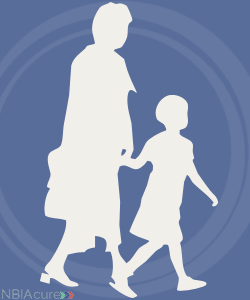 How to prepare for a genetic counseling appointment (in-person or over the phone)
How to prepare for a genetic counseling appointment (in-person or over the phone)
Since many people have never heard of genetic counseling, their first appointment with a genetic counselor can be an intimidating and confusing experience. One way to ease this stress is to prepare for the appointment by following some of these suggestions:
- Talk to family members and try to find out medical information about siblings, parents, aunts, uncles, cousins, grandparents, children, and grandchildren
- Gather the medical records of the individual diagnosed with (or suspected of having) an NBIA disorder
- Bring a friend or family member to the appointment
- For emotional support
- To help remember all of the information that will be provided
- Write down questions and concerns in advance
- Bring a notepad and pen to take notes during the appointment or phone call
What is discussed during a genetic counseling appointment?
Patients often talk to a genetic counselor if they or a family member are suspected of having an NBIA disorder. The topics discussed during a genetic counseling appointment can vary depending on the patient’s concerns and where the patient is in the diagnostic process. Common genetic counseling topics for NBIA disorders are:
- Implications of an NBIA diagnosis
- Family health history (pedigree)
- Inheritance patterns
- Testing of family members
- Genetic Testing
- Family planning
Implications of an NBIA diagnosis or other test results
Individuals typically see a genetic counselor when they are suspected of having an NBIA disorder and are going through testing to determine a diagnosis. In those cases, one of the first things a genetic counselor may discuss is the steps of the testing process and what to expect.
An NBIA disorder can be diagnosed through a mixture of clinical signs and genetic testing. Genetic testing is more conclusive and less subjective to individual interpretation so it is the preferred method of diagnosis confirmation.
Genetic testing can have a few different results:
Positive
- The testing shows a clear connection between the gene change(s) found in a person and the NBIA disorder they are suspected to have
- The clinical symptoms and MRI are very clearly associated with one particular NBIA subtype
Likely Positive
- The testing found only one gene change when usually two gene changes are needed to confirm the diagnosis of a particular NBIA disorder*
- The clinical symptoms and MRI are very clearly associated with one particular NBIA disorder
- In these cases, a clear genetic testing result isn’t needed to make a diagnosis, and the clinical symptoms may be enough to give a diagnosis of NBIA
Inconclusive (VOUS)
- V.U.S stands for “variant of unknown significance”
- This means that a change in the gene was found, but it is not clear whether it is a harmless variation or something more. Sometimes prediction programs can try to guess whether the change could cause disease.
- The clinical symptoms and MRI appear to indicate an NBIA diagnosis, but it is unclear whether the gene change found is the cause. More testing may be recommended.
Negative
- No gene changes were found or only a VOUS was found through genetic testing
- The clinical symptoms and/or MRI don’t strongly indicate an NBIA disorder
* When only one or no gene changes are found, that does not automatically mean the person does not have NBIA. Due to genetic testing limitations, we may not yet have the technology to find that gene change.
The confusing results and implications seen above are one of the reasons why it is strongly recommended to see a genetic counselor before undergoing genetic testing. A genetic counselor will make sure you fully understand the testing procedure, the benefits and limitations of the test, and the possible consequences of the test results.
Sometimes individuals and/or families are not able to decide whether they want to undergo genetic testing or are going through emotional distress that makes it difficult to make a clear-minded decision. In these cases, a genetic counselor can be an important ally in helping individuals figure out if genetic testing will answer the questions they have or if it might be better to put off testing until a later time. The diagnosis process can be an exhausting and confusing time and it is helpful to have a patient advocate like a genetic counselor to guide you to the path that meets your needs.
Family Health History (Pedigree)
What is a pedigree?
A pedigree is a diagram that shows how different family members are related and what medical conditions have been diagnosed in the family. In pedigrees, a square symbol is used to represent males and a circle is used for females. Vertical lines extending downward from a couple represent their children. Each generation is written underneath their parental generation so the oldest individuals are at the top of the page. When a pedigree is used to investigate a genetic condition, individuals who have that condition are filled in solid while those who are carriers of the condition are only half-filled.

How are pedigrees used by genetic counselors?
Genetic counselors use pedigrees like the one above to figure out how certain conditions are being passed down through a family and which family members, who may seem healthy now, could be at risk of already having that condition or developing it later.
Inheritance Patterns
The way in which a condition or trait is passed down through families is called an inheritance pattern. There are four major inheritance patterns: autosomal dominant, autosomal recessive, X-linked dominant and X-linked recessive. Out of these four patterns, only 3 are seen in NBIA disorders, and autosomal recessive is the most common.
| NBIA Disorder | Inheritance Pattern |
|---|---|
| PKAN | Autosomal Recessive |
| PLAN | Autosomal Recessive |
| MPAN | Autosomal Recessive |
| FAHN | Autosomal Recessive |
| Kufor-Rakeb syndrome | Autosomal Recessive |
| Aceruloplasminemia | Autosomal Recessive |
| Woodhouse-Sakati syndrome | Autosomal Recessive |
| CoPAN | Autosomal Recessive |
| Neuroferritinopathy | Autosomal Dominant |
| BPAN | X-Linked Dominant |
For more information about genes, chromosomes, and inheritance patterns, please visit the Genetics page.
Autosomal Recessive Inheritance
“Autosomal” refers to the fact that the gene change that causes the condition seen in the family is located on one of the autosomes (chromosome pairs 1-22). Since the sex chromosomes are not involved, males and females are equally likely to inherit the gene change. “Recessive” refers to the fact that a gene change must be present in both copies of a particular gene for the person to express a trait/condition. Therefore, a copy of the gene change must be inherited from both the father and the mother. If an individual has only one recessive gene change, then they are called a “carrier” for that trait or condition. Carriers do not have health problems related to that gene change and often do not know they carry a recessive gene change.
However, if two carriers have a child together, then there is a 25% chance that they will both pass on their recessive gene changes and have a child with that trait or condition. As seen in the image to the left, in a pregnancy between two carriers, there is a 25% chance of the child having the condition, a 50% chance that the child will be a carrier like the parents and a 25% chance that the child will not have the condition and will not even be a carrier.
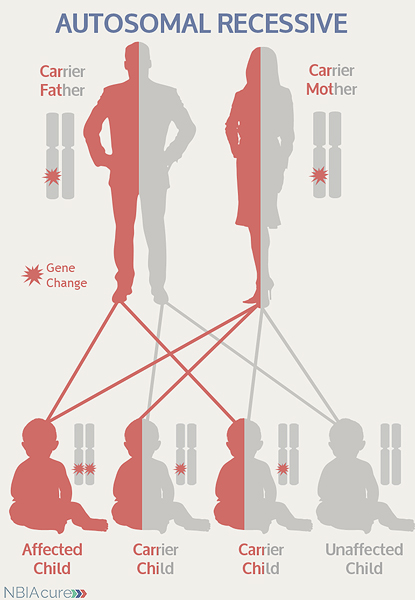 The image to the left can sometimes be misleading because it makes it seem that if a couple has four children, only one of them will be affected. In other words, that if they have one affected child, their next child will be unaffected. However, that is not always the case, and some couples can have multiple children with NBIA. The chance of two carriers having an affected child is 1 in 4 (25%) for EACH pregnancy.
The image to the left can sometimes be misleading because it makes it seem that if a couple has four children, only one of them will be affected. In other words, that if they have one affected child, their next child will be unaffected. However, that is not always the case, and some couples can have multiple children with NBIA. The chance of two carriers having an affected child is 1 in 4 (25%) for EACH pregnancy.
The birth of a child with a recessive condition is often a total surprise to a family, since in most cases there is no previous family history of the condition. It is estimated that each person carries about 20 recessive genes that cause genetic diseases or conditions. When a person has a child with a partner that carries the same recessive gene change, then there is a chance of having a child with a recessive disorder. Recessive conditions happen more often in cultures where marriage occurs between extended family members, such as cousins, because they are more likely to be carriers of the same recessive genes.
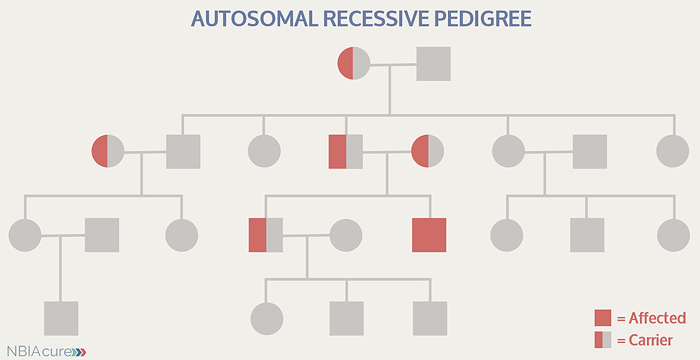
A pedigree of a family with an autosomal recessive condition (or gene change) would show:
- The condition appears to skip generations
- Multiple family members are carriers
- Males and females are equally affected
Autosomal Dominant Inheritance
“Autosomal” refers to the fact that the gene change that causes the condition seen in the family is located on one of the autosomes (chromosome pairs 1-22). Since the sex chromosomes are not involved, that means that males and females are equally likely to inherit the gene change. “Dominant” refers to the fact that having a gene change in just one of the two gene copies is all it takes for a person to express a trait/condition.
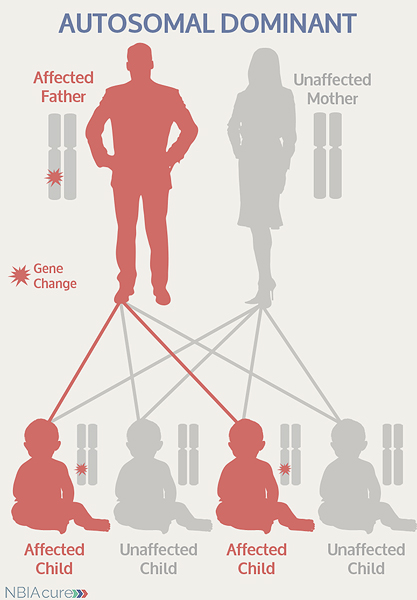
As seen in the image to the left, when one parent has a dominant gene change, there is a 50% chance that any child they have will inherit that change. Since the gene change is located on an autosome, the gender of the child (whether it is a son or daughter) does not affect this pattern. Girls and boys will be affected equally.
The image to the left can sometimes be misleading because it makes it seem that if a couple has four children, only two of them will be affected. In other words, that if they have one affected child, their next child will be unaffected. However, that is not always the case, and some couples can have multiple children with NBIA. The chance of an affected parent having an affected child is 1 in 2 (50%) for EACH pregnancy.
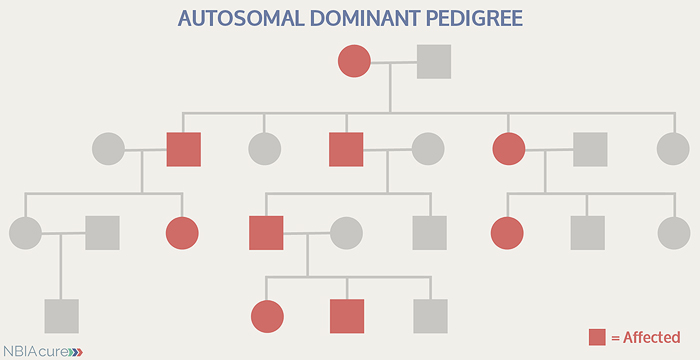
A pedigree of a family with an autosomal dominant condition (or gene change) would show:
- The condition affects every generation
- There are no carriers
- Males and females are equally affected
- An unaffected individual cannot have an affected child
X-Linked Inheritance
“X-linked” means that the gene containing the change is located on the X chromosome. As mentioned earlier, females have two X chromosomes and males have one X and one Y. Therefore, the way an X-linked gene change is expressed may be different in males than females.
Alterations in X chromosome genes can be recessive or dominant. Among all the NBIA disorders, X-linked inheritance has only been observed in the BPAN form. “Dominant” means that a change in just one of the two copies of a particular gene is all it takes for a person to express a trait/condition. This means that a change in one particular gene (WDR45) on a single X chromosome is all it takes to cause BPAN.
A child’s chance of inheriting a X-linked dominant condition changes depending on whether their mother or father are affected. Men have one X chromosome and one Y chromosome so fathers pass on their X chromosome to their daughters and their Y chromosome to their sons. An affected father will pass on his changed X chromosome to all of his daughters, so all of them will be affected. An affected father will not pass his changed X chromosome to his sons (because they will receive his Y chromosome), so all of his sons will be unaffected. Females have two X chromosomes so they give one X chromosome to their daughters and their sons. Therefore, an affected mother has a 50% chance of passing on her single changed X chromosome to every child she has.
Although the gene for BPAN is located on the X chromosome and behaves in a dominant way, this inheritance pattern has not been seen in any BPAN family trees. Instead, all of the WDR45 gene changes seen so far are new in the affected individuals. Instead of inheriting it from a parent, the gene change most likely occurred very early in development, either in the sperm or egg, or shortly after the egg was fertilized and started to develop.
Copyright © 2014 by NBIAcure.org. All rights reserved.